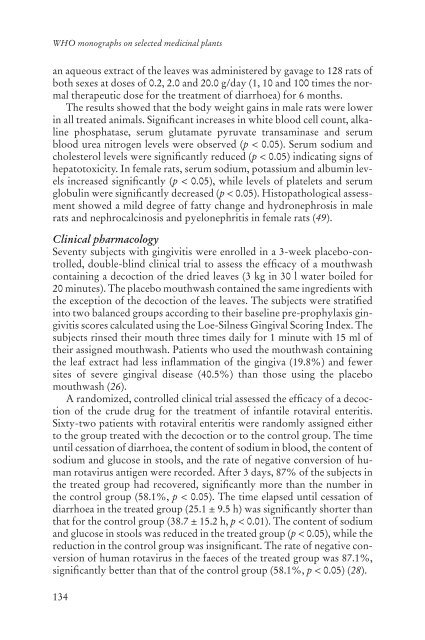WHO monographs on selected medicinal plants - travolekar.ru
WHO monographs on selected medicinal plants - travolekar.ru
WHO monographs on selected medicinal plants - travolekar.ru
You also want an ePaper? Increase the reach of your titles
YUMPU automatically turns print PDFs into web optimized ePapers that Google loves.
<str<strong>on</strong>g>WHO</str<strong>on</strong>g> <str<strong>on</strong>g>m<strong>on</strong>ographs</str<strong>on</strong>g> <strong>on</strong> <strong>selected</strong> <strong>medicinal</strong> <strong>plants</strong><br />
an aqueous extract of the leaves was administered by gavage to 128 rats of<br />
both sexes at doses of 0.2, 2.0 and 20.0 g/day (1, 10 and 100 times the normal<br />
therapeutic dose for the treatment of diarrhoea) for 6 m<strong>on</strong>ths.<br />
The results showed that the body weight gains in male rats were lower<br />
in all treated animals. Significant increases in white blood cell count, alkaline<br />
phosphatase, se<strong>ru</strong>m glutamate py<strong>ru</strong>vate transaminase and se<strong>ru</strong>m<br />
blood urea nitrogen levels were observed (p < 0.05). Se<strong>ru</strong>m sodium and<br />
cholesterol levels were significantly reduced (p < 0.05) indicating signs of<br />
hepatotoxicity. In female rats, se<strong>ru</strong>m sodium, potassium and albumin levels<br />
increased significantly (p < 0.05), while levels of platelets and se<strong>ru</strong>m<br />
globulin were significantly decreased (p < 0.05). Histopathological assessment<br />
showed a mild degree of fatty change and hydr<strong>on</strong>ephrosis in male<br />
rats and nephrocalcinosis and pyel<strong>on</strong>ephritis in female rats (49).<br />
Clinical pharmacology<br />
Seventy subjects with gingivitis were enrolled in a 3-week placebo-c<strong>on</strong>trolled,<br />
double-blind clinical trial to assess the efficacy of a mouthwash<br />
c<strong>on</strong>taining a decocti<strong>on</strong> of the dried leaves (3 kg in 30 l water boiled for<br />
20 minutes). The placebo mouthwash c<strong>on</strong>tained the same ingredients with<br />
the excepti<strong>on</strong> of the decocti<strong>on</strong> of the leaves. The subjects were stratified<br />
into two balanced groups according to their baseline pre-prophylaxis gingivitis<br />
scores calculated using the Loe-Silness Gingival Scoring Index. The<br />
subjects rinsed their mouth three times daily for 1 minute with 15 ml of<br />
their assigned mouthwash. Patients who used the mouthwash c<strong>on</strong>taining<br />
the leaf extract had less inflammati<strong>on</strong> of the gingiva (19.8%) and fewer<br />
sites of severe gingival disease (40.5%) than those using the placebo<br />
mouthwash (26).<br />
A randomized, c<strong>on</strong>trolled clinical trial assessed the efficacy of a decocti<strong>on</strong><br />
of the c<strong>ru</strong>de d<strong>ru</strong>g for the treatment of infantile rotaviral enteritis.<br />
Sixty-two patients with rotaviral enteritis were randomly assigned either<br />
to the group treated with the decocti<strong>on</strong> or to the c<strong>on</strong>trol group. The time<br />
until cessati<strong>on</strong> of diarrhoea, the c<strong>on</strong>tent of sodium in blood, the c<strong>on</strong>tent of<br />
sodium and glucose in stools, and the rate of negative c<strong>on</strong>versi<strong>on</strong> of human<br />
rotavi<strong>ru</strong>s antigen were recorded. After 3 days, 87% of the subjects in<br />
the treated group had recovered, significantly more than the number in<br />
the c<strong>on</strong>trol group (58.1%, p < 0.05). The time elapsed until cessati<strong>on</strong> of<br />
diarrhoea in the treated group (25.1 ± 9.5 h) was significantly shorter than<br />
that for the c<strong>on</strong>trol group (38.7 ± 15.2 h, p < 0.01). The c<strong>on</strong>tent of sodium<br />
and glucose in stools was reduced in the treated group (p < 0.05), while the<br />
reducti<strong>on</strong> in the c<strong>on</strong>trol group was insignificant. The rate of negative c<strong>on</strong>versi<strong>on</strong><br />
of human rotavi<strong>ru</strong>s in the faeces of the treated group was 87.1%,<br />
significantly better than that of the c<strong>on</strong>trol group (58.1%, p < 0.05) (28).<br />
134

















